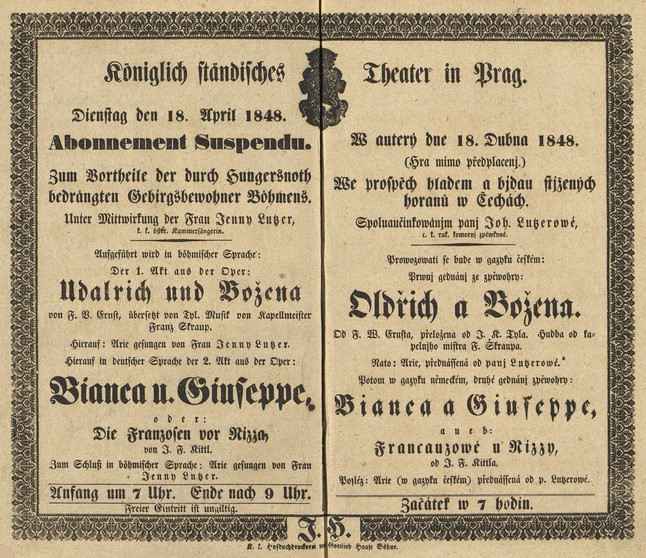We are developing a set or methods and specific tools for the purpose of preserving, managing, and making historical theatre posters accessible to users, focusing especially on the poster collections in the National Museum in Prague and in the Moravian Museum in Brno.
In conjunction with the Theatre Department of the National Museum (Mgr. Markéta Trávníčková, principal investigator and coordinator) and the Department of Theatre History at the Moravian Museum (PhDr. Jaroslav Blecha, project coordinator) the department obtained support for work on a research project for 2016–2020. The project is funded under the NAKI II programme and its identification code is DG16P02B008.
Project goal
Our goal is devise a specific set of methods and tools designed for the purpose of preserving, managing, and making historical theatre posters accessible to users. Historical theatre posters are one of the richest sources of information on the history of the theatre. Made out of paper, however, they suffer with frequent use, especially since the paper is often poor quality and large posters tend to have been stored folded up into bundles. The set of methods and tools developed in this project will prevent theatre posters from suffering further damage, and will make it possible to conserve them for the future as a preservation collection and draw on their as yet untapped potential as a source of information using modern techniques. It will be possible to use these methods and tools to process all collections in the Czech Republic that contain theatre posters. As part of the project we are therefore also taking stock and making a record of historical theatre posters scattered through the collections of various museums, archives, libraries, and private collection.
Focal period
This research focuses on the 19th century, the time when Czech-language theatre began to emerge and grow and in which we can trace and identify its particular features. Czech-language theatre did not come into existence alone but made its step by step into an arena of activity that was richly developed and established for centuries by German and Italian theatre, which Czech theatre then drew on in all variety of ways.
What are theatre posters?
Theatre posters are one of the richest sources of information on the history of the theatre. These paper notices invited the public to come attend a planned performance. The dimensions of posters varied depending on their purpose. Large posters were put up on the theatre building, smaller announcements were distributed to the homes of subscribers and anyone else interested. The posters contained all the basic information about a performance (the location, the building, the theatre company, the ensemble, the date and time, the title of the performance, and the artists and performers involved). These sources can be used to reconstruct and study the repertoires of theatres, lists of productions, performers, and artists (directors, conductors, choreographers, actors, singers, and dancers), information about guest performances, ticket prices, subscription options, popular arias and librettos, scenic designs and set changes, special effects, and even personal invitations and comments from the head of a theatre.
The department’s team is working on the following tasks
- developing methods for harvesting information from posters about performances and productions and verifying and supplementing the information;
- making a record of the theatre posters located in the collections of museums, archives, libraries, theatres, and private collections (it should be possible for the developed set of methods to be used at other institutions that have posters in their collections),
- conducting research on theatre history and exploring historical topics using the methods and tools developed in the project.
Research team
- Alena Jakubcová, Jitka Ludvová, Václav Štěpán, Milan Pospíšil
- Collaborators: Pavel Petráněk, Jan Boukal, Matouš Vanča, Martin Hanoušek, Berenika Zemanová Urbanová, Alena Jakubcová ml., Johana Černá, Jan David
- Administration: Ludmila Kindlerová, Jana Hojková
Planned outcomes of the project:
- a certified set of methods,
- a specialised informative map,
- exhibitions,
- databases,
- a specialised book (exhibition catalogue),
- a study.
Studies published to date:
- Jitka Ludvová: ‘K dění ve Stavovském divadle v letech 1801–1806’ (Events at the Estates Theatre 1801–1806), Divadelní revue 27, 2016, no. 2, pp. 93–111.
- Markéta Trávníčková: ‘Unikáty sbírky cedulí a plakátů Divadelního oddělení Národního muzea’ (The Unique Poster Collections of the Theatre Department at the National Museum), Časopis Národního muzea (řada historická) 186, 2017, nos. 1–2, forthcoming.
- Jaroslav Blecha: ‘Sbírka divadelních cedulí a plakátů v Oddělení dějin divadla Moravského zemského muzea’ (The Collection of Theatre Posters in the Department of Theatre History at the Moravian Museum), Acta Mus. Moraviae, Sci. soc., CII: 2, 2017, forthcoming.
- Milan Pospíšil: ‘Bedřich Smetana a Riegrova rodina’ (Bedřich Smetana and the Rieger family), Hudební věda 54, 2017, no. 2, pp. 179–200.

